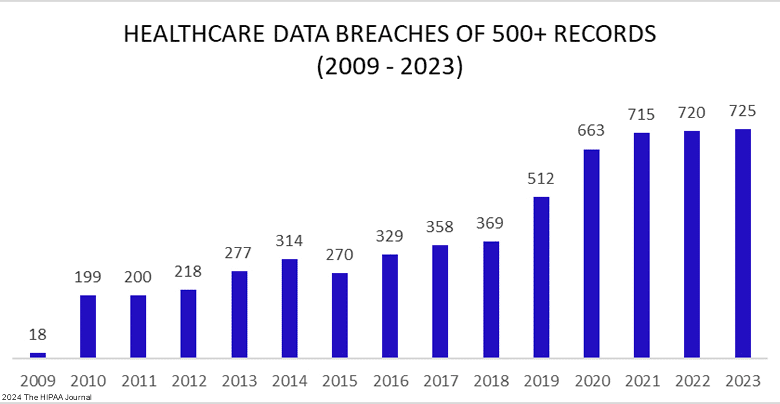Healthcare Cybersecurity: Preventing Data Breaches

Healthcare organizations find themselves today at the forefront of a disturbing trend: a seemingly unending onslaught of data breaches. These nefarious incidents, far from being isolated occurrences, have emerged as a persistent and pervasive threat, one that demands immediate and comprehensive action to safeguard patient privacy and operational integrity.
Understanding the Magnitude of Healthcare Data Breaches
The unique sensitivity and value of protected health information (PHI) make it a prime target for identity theft, phishing attacks, and ransomware attacks, thereby underscoring the magnitude of prioritizing data security within the healthcare sector. Ensuring robust cybersecurity measures are not just about compliance; it’s about protecting individuals’ most intimate data from cybercriminals who are continuously evolving in their methods of attack.
Statistics and Trends
The healthcare industry faces an escalating threat from cyberattacks, with the volume and severity of data breaches reaching unprecedented levels. In 2023 alone, the Department of Health and Human Services (HHS) Office for Civil Rights (OCR) reported a record-setting 725 large security breaches, surpassing the previous year’s total.
This trend marks a significant increase from just a few years ago, where the reporting rate was approximately one large data breach per day. Now, it stands at two per day, highlighting the growing frequency and sophistication of attacks targeting the sector.
The magnitude of these breaches is equally alarming. The year 2023 set a new high for the number of breached healthcare records, totaling over 133 million. This represents a 156% increase from the previous year, demonstrating not only the frequency but also the scale of these incidents. Among these, there were 114 breaches involving more than 100,000 records, including 26 breaches affecting over 1 million records, and one particularly devastating breach impacting 11.27 million records.
High-profile Cases
The healthcare sector has witnessed several high-profile data breaches, underscoring the critical vulnerabilities within its cybersecurity frameworks. For instance, HealthEC, a New Jersey-based analytics software vendor, experienced a breach through which hackers accessed a system used by over 1 million healthcare professionals. This breach compromised the protected health information of approximately 4.45 million individuals.
Another significant breach occurred at ESO Solutions, a provider of software solutions for emergency medical services, which suffered a network breach leading to file encryption by ransomware. This incident affected at least 12 health systems and hospitals, impacting the data security of numerous patients.
Moreover, the Clop hacking group exploited a zero-day vulnerability in Progress Software’s MOVEit Transfer solution, affecting more than 2,600 organizations globally, with the healthcare industry being one of the most impacted. This breach highlights the increasing sophistication of cyberattacks and the challenges in protecting healthcare data against such threats.
These examples illustrate not only the scale but also the severity of data breaches in the healthcare sector, emphasizing the urgent need for enhanced cybersecurity measures to protect sensitive patient information and maintain trust in healthcare services.
Common Causes of Data Breaches in Healthcare
The healthcare industry, while advancing in digital capabilities, faces significant vulnerabilities that attract cybercriminals. The common causes of data breaches in this sector can be broadly categorized into system vulnerabilities, human error, and cyber attacks. Each category presents unique challenges and requires targeted strategies to mitigate risks effectively.
System Vulnerabilities
Healthcare systems often rely on a complex network of technologies including outdated legacy systems, third-party vendors, and an increasing array of Internet of Medical Things (IoMT) devices. These systems frequently suffer from security vulnerabilities due to insufficient updates and patches. For example, outdated systems may no longer receive manufacturer support, leaving them susceptible to new threats. Additionally, the extensive use of third-party services increases risk exposure, as these vendors may not always employ stringent cybersecurity measures. A staggering number of healthcare organizations store sensitive data in the cloud without adequate security, making them prime targets for breaches.
Human Error
Human error remains one of the largest contributors to data breaches within healthcare. This includes errors by employees, contractors, and vendors who may inadvertently expose the network to cyber threats. Common mistakes include the misuse of credentials, falling for phishing scams, and inadequate training on cybersecurity best practices. For instance, the use of weak or default passwords can allow easy access for cybercriminals. Studies have shown that a significant portion of breaches results from general carelessness and a failure to adhere to security protocols, underscoring the need for comprehensive and continuous training.
Cyber Attacks
Cybercriminals are increasingly sophisticated in their methods to exploit healthcare systems. Ransomware attacks, phishing, and advanced malware are common tools used to breach healthcare data. The healthcare sector’s high-value data makes it a lucrative target for attackers looking to sell stolen information on the dark web or use it for further criminal activities. Recent reports indicate a sharp increase in the number of attacks, particularly through ransomware, highlighting an urgent need for healthcare facilities to strengthen their cybersecurity defenses.
These vulnerabilities not only compromise patient privacy but also disrupt healthcare operations, leading to significant financial and reputational damage. Addressing these issues requires a robust cybersecurity framework and a proactive approach to safeguarding patient data against the evolving landscape of cyber threats.
Impact of Data Breaches on Healthcare Organizations
Financial Costs
Data breaches in healthcare organizations lead to significant financial burdens, with the average cost of a healthcare data breach reaching approximately $10.93 million. This staggering figure encompasses a variety of financial impacts, including the immediate costs of responding to the breach, legal fees, HIPAA violation fines, and increased insurance premiums. Additionally, healthcare organizations face potential lawsuits and a loss of revenue as patients move to other providers due to diminished trust. The cost per lost or stolen record is notably higher in healthcare, averaging around $499, which is significantly above the average across other industries.
Reputational Damage
The reputational impact of a data breach can be profound and long-lasting for healthcare organizations. Data breaches not only damage the public image of healthcare providers but also deter potential staff and associates who might be concerned about their professional reputation and the security of their own data. The erosion of patient confidence is particularly detrimental; it is built over years of interactions and once lost, can be challenging to regain. This loss of trust can lead patients to seek care elsewhere, further affecting the healthcare organization’s standing in the community and its operational viability.
Patient Privacy Concerns
Breaches compromise the privacy and security of patients’ personal, medical, and financial information, leading to identity theft and other forms of cybercrime. The sensitive nature of health records makes them a prime target for attackers, and once this information is compromised, it can lead to serious consequences for patients. For instance, unauthorized changes to a patient’s medical history or prescriptions can result in improper treatment, posing significant health risks. Furthermore, the psychological impact, including stress and anxiety about personal data security, can deter patients from sharing essential health information with their providers, compromising future medical care. The legal and financial repercussions for healthcare providers in such instances are severe, underscoring the need for robust security measures and effective breach-response strategies.
Preventive Measures for Healthcare Data Security
Robust Cybersecurity Infrastructure
To safeguard sensitive health information effectively, healthcare organizations must establish a robust cybersecurity infrastructure. This involves implementing strong encryption protocols for data at rest and in transit, ensuring that even if data is intercepted, it remains secure and unreadable. Additionally, robust access controls are crucial. Adopting the principle of least privilege ensures that employees have access only to the data necessary for their roles, thereby minimizing the risk of insider threats and reducing the potential for unauthorized data access. Regular updates and reviews of access controls are essential to adapt to changes in staff roles and responsibilities.
Regular Audits and Risk Assessments
Conducting regular security audits and cybersecurity maturity assessments (CSMAs) is vital for identifying and addressing vulnerabilities within healthcare systems. These audits, carried out by internal or external experts, help ensure that security measures are up-to-date and effective. For organizations facing financial and logistical constraints, prioritizing audits of the most critical systems offers a manageable approach. Regular risk assessments are also crucial as they help healthcare organizations identify potential risks to patient safety, data privacy, and regulatory compliance, thereby enabling them to prioritize resources and implement appropriate mitigation strategies.
Staff Training and Awareness
The human element plays a significant role in cybersecurity. Providing comprehensive security awareness training (SAT) helps change employee behavior and strengthens the overall security posture of the organization. Training should include topics such as recognizing phishing attempts, the importance of strong password practices, and the proper handling of patient data. Regular, focused training sessions enhance staff awareness and preparedness against cyber threats. Additionally, including simulated phishing emails and reviewing actual scenarios of healthcare breaches in training sessions can be particularly effective in educating staff about cybersecurity best practices.
Implementing these preventive measures is essential for healthcare organizations to protect against data breaches and cyberattacks, ensuring the security and privacy of patient information.
Conclusion
Throughout the discourse on healthcare cybersecurity, we’ve underscored the paramount importance of establishing and maintaining rigorous security protocols to protect sensitive patient information against an ever-evolving array of cyber threats. From understanding the vast repercussions of data breaches on patient trust and financial stability, to dissecting the multifaceted causes—be it system vulnerabilities, human error, or direct cyber attacks—the need for a holistic approach to cybersecurity within healthcare is crystal clear. Implementing comprehensive measures such as beefed-up security infrastructures, regular risk assessments, and continuous staff training, encapsulates our discussion’s core message: the safeguarding of patient data is not merely a regulatory compliance issue but a foundational component of healthcare’s integrity and trustworthiness.
As we navigate through the complex digital landscape of modern healthcare, the broader implications of our findings compel a shift towards more resilient, proactive cybersecurity strategies. The exponential rise in cyberattacks highlights an urgent need for the healthcare sector to adopt and adapt to enhanced protective measures, lest the ramifications of breaches become increasingly catastrophic. The call to action for healthcare providers is unequivocal—bolster your cybersecurity defenses, thereby ensuring not only the protection of patient data but also securing the foundation upon which patient-provider relationships stand. Reflecting upon these discussions, it’s evident that prioritizing cybersecurity is not optional; it is imperative for the continued viability and trust in healthcare services.
How Apono Helps
Apono aids companies in the healthcare industry in preventing data breaches by implementing advanced security protocols and compliance measures tailored to the sector’s unique needs. Apono ensures that sensitive patient information remains secure. Additionally, the platform offers comprehensive access control systems, allowing organizations to manage user permissions effectively. By adhering to industry standards such as HIPAA, Apono not only protects data but also helps healthcare providers avoid costly fines and reputational damage associated with breaches. This multi-layered approach fortifies the integrity and confidentiality of healthcare data, fostering trust and reliability.
*** This is a Security Bloggers Network syndicated blog from Apono authored by Rom Carmel. Read the original post at: https://www.apono.io/blog/healthcare-cybersecurity/



